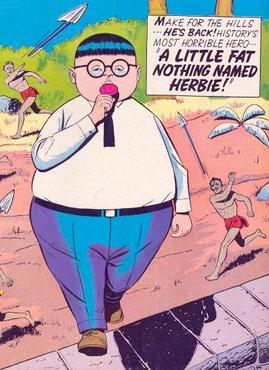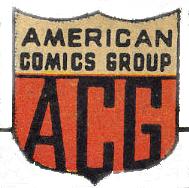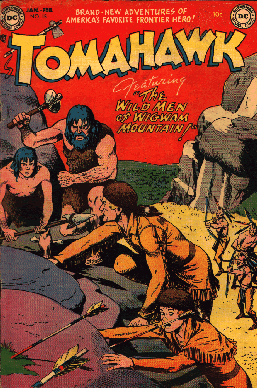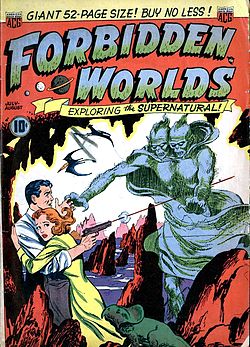
All-American Comics is a comics anthology and the flagship title of comic book publisher All-American Publications, one of the forerunners of DC Comics. It ran for 102 issues from 1939 to 1948. Characters created for the title, including Green Lantern, the Atom, the Red Tornado, Doctor Mid-Nite, and Sargon the Sorcerer, later became mainstays of the DC Comics line.

An American comic book is a thin periodical originating in the United States, on average 32 pages, containing comics. While the form originated in 1933, American comic books first gained popularity after the 1938 publication of Action Comics, which included the debut of the superhero Superman. This was followed by a superhero boom that lasted until the end of World War II. After the war, while superheroes were marginalized, the comic book industry rapidly expanded and genres such as horror, crime, science fiction and romance became popular. The 1950s saw a gradual decline, due to a shift away from print media in the wake of television and the impact of the Comics Code Authority. The late 1950s and the 1960s saw a superhero revival and superheroes remained the dominant character archetype throughout the late 20th century into the 21st century.

Herbie Popnecker is a fictional comic book character who first appeared in Forbidden Worlds #73 in December 1958, published by American Comics Group. He was created by Richard E. Hughes and Ogden Whitney.
Don Markstein's Toonopedia is an online encyclopedia of print cartoons, comic strips and animation, initiated February 13, 2001. Donald D. Markstein, the sole writer and editor of Toonopedia, termed it "the world's first hypertext encyclopedia of toons" and stated, "The basic idea is to cover the entire spectrum of American cartoonery."

American Comics Group (ACG) was an American comic book publisher started in 1939 and existing under the ACG name from 1943 to 1967. It published the medium's first ongoing horror-comics title, Adventures into the Unknown. ACG's best-known character was the 1960s satirical humor hero Herbie Popnecker, who starred for a time in Forbidden Worlds. Herbie would later get his own title and be turned into a superhero called the Fat Fury.
Pete Costanza was an American comic book artist and illustrator. He is best known for his work on Fawcett Comics' Captain Marvel and the Marvel Family during the World War II era fans and historians call the Golden Age of Comic Books, and served as one of Captain Marvel's longest-tenured artists.
Richard E. Hughes (1909–1974) was an American writer and editor of comic books. He was editor of the American Comics Group through the company's entire existence from 1943 to 1967, and wrote most of that publisher's stories from 1957 to 1967 under a variety of pseudonyms. His best-known character is Herbie Popnecker, created under the pseudonym Shane O'Shea, with artist Ogden Whitney.

Tomahawk is an American comic book character whose adventures were published by DC Comics during the 1940s, 1950s and 1960s as a backup feature in Star Spangled Comics and World's Finest Comics and in his own eponymous series. He was created by writer Joe Samachson and artist Edmond Good, and first appeared in Star-Spangled Comics #69. Tomahawk's uniqueness stems in part from the time frame of his adventures: the American Revolutionary War.

Jungle Jim is the fictional hero of a series of jungle adventures in various media. The series began on January 7, 1934, as an American newspaper comic strip chronicling the adventures of Asia-based hunter Jim Bradley, who was nicknamed Jungle Jim. The character also trekked through radio, film, comic book and television adaptations. Notable was a series of films and television episodes in which Johnny Weissmuller portrayed the safari-suit wearing character, after hanging up his Tarzan loincloth. The strip concluded on August 8, 1954.

John Francis Rosenberger, also occasionally credited as John Diehl, was an American comics artist and painter from after the Second World War until the mid-1970s. Educated at the Pratt Institute, he worked primarily in the romance and superhero genres of comics, with forays into many other subjects.
Charlton Media Group (CMG) is a Montreal-based publisher owned and operated by Canadian entrepreneur Roger Broughton. CMG has published Charlton Comics and American Comics Group reprint comics, under several names, including Sword in Stone, A+, and America's Comics Group.
Samuel Joseph Glanzman was an American comics artist and memoirist. Glanzman is best known for his Charlton Comics series Hercules, about the mythological Greek demigod; his autobiographical war stories about his service aboard the U.S.S. Stevens for DC Comics and Marvel Comics; and the Charlton Comics Fightin' Army feature "The Lonely War of Willy Schultz", a Vietnam War-era serial about a German-American U.S. Army captain during World War II.

Magazine Enterprises was an American comic book company lasting from 1943 to 1958, which published primarily Western, humor, crime, adventure, and children's comics, with virtually no superheroes. It was founded by Vin Sullivan, an editor at Columbia Comics and before that the editor at National Allied Publications, the future DC Comics.

The Skyman is a fictional comic book superhero that appeared stories during the Golden Age of Comic Books. Created by writer Gardner Fox and artist Ogden Whitney, the character first appeared in the Columbia Comics omnibus title Big Shot Comics #1. He is unrelated to the DC Comics character.

John Ogden Whitney was an American comic-book artist and sometime writer active from the 1930s–1940s Golden Age of comics through the 1960s Silver Age. He is best known as co-creator of the aviator hero Skyman and of the superpowered novelty character Herbie Popnecker and his alter ego, the satiric superhero the Fat Fury. Whitney as well had long runs on characters as diverse as the Western masked crime-fighter the Two-Gun Kid, and the career-girl character Millie the Model.
Novelty Press was an American Golden Age comic-book publisher that operated from 1940 to 1949. It was the comic book imprint of Curtis Publishing Company, publisher of The Saturday Evening Post. Among Novelty's best-known and longest-running titles were the companion titles Blue Bolt and Target Comics.

Hangman Comics was the name of an American anthology comic book series published by MLJ Magazines Inc., more commonly known as MLJ Comics, for seven issues between Spring 1942 and Fall 1943. It featured MLJs costumed vigilante The Hangman, and "Boy Buddies", featuring Shield's partner 'Dusty the Boy Detective' and Wizard's side-kick 'Roy the Superboy', throughout the series.

Western comics is a comics genre usually depicting the American Old West frontier and typically set during the late nineteenth century. The term is generally associated with an American comic books genre published from the late 1940s through the 1950s. Western comics of the period typically featured dramatic scripts about cowboys, gunfighters, lawmen, bounty hunters, outlaws, and Native Americans. Accompanying artwork depicted a rural America populated with such iconic images as guns, cowboy hats, vests, horses, saloons, ranches, and deserts, contemporaneous with the setting.
Benjamin William Sangor was an American publisher best known for the 1940s to 1950s comic book company American Comics Group and for operating one of the earliest studios of comic-book writers and artists packaging comics for publishers entering the fledgling medium. He additionally was a real-estate entrepreneur.

Blue Beetle is a long running comic book series featuring the superhero of the same name. Throughout its publication, the series has had three main characters who have each assumed the mantle of the Blue Beetle: Dan Garret, Ted Kord and Jaime Reyes. The series has been canceled and relaunched several times: its first volume was published by Fox Feature Syndicate and Holyoke Publishing, with subsequent volumes published by Charlton Comics and then DC Comics. Since 1986, the series and its characters have been integrated into the shared DC Universe.













